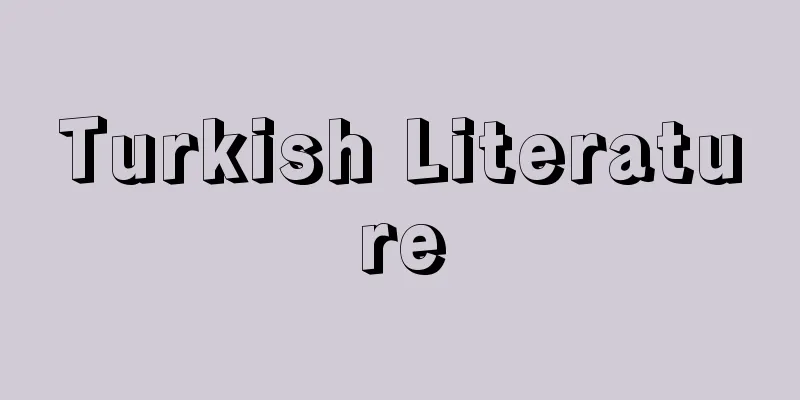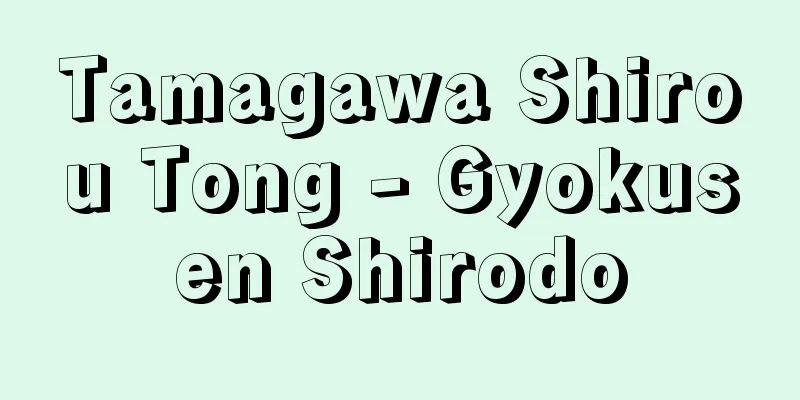Turkish Literature

|
Historically, Turkish literature can be broadly divided into three periods. [Yuzo Nagata] Pre-IslamicFirst, there are the Turkic inscriptions, a literary heritage from the 8th to 11th centuries, before the Turks converted to Islam. These were excavated in 1889 on the banks of the Orkhon River and date to the early 8th century, making them the oldest surviving Turkish literary remains. In addition, inscriptions and manuscripts written in Turkic and Uighur scriptures have been discovered in the upper reaches of the Yenisei River and in Central Asia. These include inscriptions recording the achievements of the Khagan clan and meritorious officials, Buddhist scriptures, Nestorian scriptures, and translations of the Manichaean texts, and show that the Turkish language developed quite early on. [Yuzo Nagata] Post-IslamThe first literary work by the Islamized Turks was Kutadkbilik (Happy Knowledge) (1069) by Yusuf, a chamberlain of the Kara-Khanid dynasty, which is a work of over 6,000 verses that contains the knowledge of kings and officials, as well as their views on life and the world, and which reflects the traditions of the Turks before Islamization. The next work was the Turkish-Arabic Dictionary (1071) by Mahmud Kashgari, a dictionary that explains the meanings of Turkish words in Arabic, and the quatrains and proverbs quoted in it not only shed light on the lives of the Turks at that time, but also serve as a valuable resource for linguistics and history. Turkish literature after the 13th century developed in three major dialects: Chagatai, Azerbaijani, and Ottoman Turkish. Chagatai was mainly used in the Timurid Dynasty in Central Asia and the Mughal Empire in India, and Chagatai literature was perfected by Neba'i, author of "Poems" and "Biographies of the Writers." Mughal Emperor Babur's "Autobiography (Babur Nama)" is also an excellent literary work. Azerbaijani literature includes the heroic epic poem "Book of Dede Korkut," which describes the life and wars of the Oghuz people in northeastern Anatolia in the 13th and 14th centuries, and Khuzuli's "Poems" and "Layla and Majnun," which appeared in the 16th century, had a great influence on later Azerbaijani and Ottoman literature. Ottoman literature of the Ottoman Empire, which was based in Anatolia, developed under the influence of Persian literature from the Seljuk Dynasty, but the mystic poet Yunus Emre and Rumi's son Sultan Warad in the 13th and 14th centuries maintained a simple Turkish language and traditional style. From the 14th to the early 15th centuries, early Ottoman literature was led by Ahmedi (1334-1413), author of "The Life of Alexander the Great," Şeyhī (1375-1431), author of "Hūsrev and Shirin," influenced by Persian poetry, and Süleyman Çelebi (?-1422), author of "Mevrid," a hymn to the Prophet Muhammad. The so-called classical period lasted from the mid-15th century to the end of the 17th century, during which folk literature such as the Köluoglu Legends, the Tales of Nasrettin Khodja, the poetry collections of the legendary minstrel Karacaolan (1606?-1689?), and Karagöz (shadow puppet theater) emerged, while court literature centered on the Ottoman monarchy developed. Works such as Bakī's (1526-1600) Ode, Nabi's Advice to a Son, and Yahyâ Bey's (?-1582) Yusuf and Zuleyhha display refined technique, incorporating an abundance of Arabic and Persian. On the other hand, historical writing by courtiers developed, with chronicles being written by such authors as Neşri (?-1520), Na'îmâ (1625-1715), and Hoca Sadeddin Efendi (1536-1599). The Tulip Period (1718-1730) was a time of revival of the classics, and Nedim's gorgeous poetry enriched court life. [Yuzo Nagata] Modern and laterAfter the Tanzimat (a Westernization reform movement carried out from 1839 to 1876) in the Ottoman Empire, Turkey entered a period of "modernization" reforms aimed at Westernization, and in the field of literature, the influence of Western Europe, especially France, became stronger, and translations were also popular. Ziya Paşa (1825-1880), Sinası, and Namık Kemal were pioneers of modern Turkish literature through the introduction of Western literary techniques, but the realistic novels of Üşakırgil and Hüseyin Rahmi Gürpnar (1864-1944) were widely read. In the 20th century, with the rise of nationalist ideas, there was a return to traditional Turkish literature. Ziya Gökalp (1876-1924), editor of the magazine The Young Pen, devoted himself to discovering folk literature and "purifying" the Turkish language (eliminating Arabic and Persian vocabulary), which led to the production of popular novels by Ömer Seyfettin, Güntekin, Halide Edip Adbal and others. After World War I, the Ottoman Empire collapsed and the Republic of Turkey was established in 1923. This was followed by drastic reforms through the "Turkish Revolution" led by Kemal Ataturk. After World War II, the Turkish economy became increasingly capitalist. Over the course of roughly half a century, Turkish society underwent a remarkable transformation. [Yuzo Nagata] Literature of the Republic of TurkeyThe ideals for building a new nation were sought in Turkish nationalism instead of Islam. In 1928, the new Turkish alphabet, written in Roman characters, was adopted instead of the Arabic alphabet, and Turkey was reborn as a modern Western nation in a short period of time. At the same time, society also underwent a major transformation, but this created a large gap between the "modernized" big cities and the rural areas where Islamic traditions still remained, and so the interest of literary scholars also turned to that direction. There were still neoclassical poets who maintained the traditions of Ottoman literature, such as Yahya Kemal, who was influenced by French symbolist poetry, but what characterizes this period is the fact that socially conscious writers flourished in the literary world. The lyrical free verse of the socialist and revolutionary poet Nazim Hikmet Ran, who studied in the Soviet Union in 1922 and was an admirer of Mayakovsky, was a prime example. He appealed for the liberation of the poor and oppressed peasants of Anatolia (Asia Minor) and preached world peace. After being imprisoned several times, he fled to Moscow, where he died (1963). However, this marked the first time in the history of Turkish literature that a novel was set in Anatolia. Güntekin's "The Wren" (1922), which depicts the suffering of a beautiful woman who is posted to Anatolia as a teacher, gained widespread popularity among the masses. Yakup Kadri Karaosmanolu (1889-1974), who is said to be the father of modern Turkish literature, made a name for himself with Nur Baba (1922), which denounced superstition in the name of Islam. He also liked to use the differences in attitudes and lifestyles between urban and rural areas as a subject, such as in The Stranger (1932). In this climate, a number of writers who graduated from the Village Teacher Training School, which was established with the aim of enlightening the Anatolian rural areas, emerged after the 1950s. Starting with Mahmut Makal's (1933- ) Our Village (1950), Fakir Baykurt (1929-1999), Talip Apaydin (1926- ), and others addressed the problems facing rural society. Also, writers appeared who depicted the contradictions of the society in southeastern Anatolia, Turkey's leading cotton-growing region, where the landlord system still remained. In this lineage, Orhan Kemal (1914-1970) and Kemal Tahir (1910-1973) can be named, and in particular Yaşar Kemal's Memet the Skinny (1955), a masterpiece that made full use of the techniques of traditional national epics, was nominated for the Nobel Prize in Literature (it is a full-length epic novel, and the fourth volume was published in 1987). On the other hand, there were also writers who conveyed the flavor of urban culture, such as Sait Faik Abasyank (1906-1954), who depicted the everyday life of ordinary Istanbul with a light touch, and the satirist Aziz Nesin, who wrapped his scathing political criticism in humor. His political criticism led to his being banned many times and even imprisoned. Another satirist, Rfat Ilgaz (1911-1993), author of "Hababam Classroom", was active from the 1960s onwards. From the early 1960s, novels about migrant workers in the former West Germany began to appear, while female writers such as Adalet Aaolu (1929- ) depicted the turbulent society of the 1970s from a female perspective. Furuzan (1935- ) published works from a social perspective, such as Free Boarding House (1971) and Siege (1972), which dealt with Turkish migrant workers in Germany. Tomris Uyar (1941-2003) was a female writer who was active from the 1970s onwards, and whose works include Silk and Copper (1971) and Summer Dream, Dream Winter (1981). Notable authors since the 1980s include Orhan Pamuk (1952- ), author of The White Castle (1985) and The Black Book (1990). Along with the development of anthropology and folklore, the rich folk literature of the Anatolian people, such as folk tales, folk songs (mani), proverbs, riddles, and hanging words, is also being unearthed. In general, modern Turkish literature is strongly influenced by American writers, and is characterized by a large number of short and medium-length stories. [Yuzo Nagata] "Hikmet Poems" by N. Hikmet, edited and translated by Nakamoto Nobuyuki and Hattori Shinroku (1969, Iizuka Shoten)" ▽ "From a Turkish Village - Report by Professor Mahmud" by Ahmut Makar, translated by Odaka Shinki (1981, Shakaishisosha)" ▽ "Selected Turkish Folktales" edited by Takeuchi Kazuo and Katsuta Shigeru (1981, Daigaku Shorin) ▽ "Nasreddin Khodja's Tale - Turkish Wisdom Tales" translated by Mori Masao (1987, Heibonsha, Toyo Bunko)" ▽ "Study of the Babur Nama" vols. 1-3 by Mano Eiji (1995, 1996, 1998, Shokado) ▽ "The Progress of Modern Turkish Literature" by Hoshina Shinichi (2001, Sobunsha) ▽ "Carole RathbunThe Village in the Turkish Novel and Short Story, 1920 to 1955" (1972, Mouton, The Hague & Paris) [References] | | | | | | | | | | | | | | | | | | | |Nebai| | | | | | |Source: Shogakukan Encyclopedia Nipponica About Encyclopedia Nipponica Information | Legend |
|
トルコ文学は歴史的にみて三つの時期に大別することができる。 [永田雄三] イスラム以前まず、トルコ人のイスラム改宗以前、8~11世紀の文学遺産に突厥碑文(とっけつひぶん)がある。これは1889年オルホン河畔で発掘されたが、8世紀初頭のもので、現存する最古のトルコ文学遺跡である。このほか、エニセイ川上流や中央アジアなどで、突厥文字やウイグル文字による碑文や写本が発見されている。これらはハガン(可汗(カガン))一族や功臣の業績を刻んだもの、仏典や景教の教典、またマニ教典の翻訳であるが、トルコ語がかなり早くから発達していたことを示している。 [永田雄三] イスラム以後イスラム化したトルコ人の最初の文学作品は、カラ・ハン朝の侍従ユースフの『クタドクビリク(幸福を与える知識)』(1069)で、王や役人の心得、人生観、世界観が6000を超える詩句のなかに盛り込まれているが、そこにはイスラム化以前のトルコ人の伝統が流れている。続く、マフムード・カシュガリーの『トルコ・アラビア語辞典』(1071)は、トルコ語の語義をアラビア語で解説した辞典であるが、そこに引用された四行詩、諺(ことわざ)によって当時のトルコ人の生活が浮き彫りにされるばかりでなく、言語学、歴史学上の貴重な資料ともなっている。 13世紀以後のトルコ文学はチャガタイ語、アゼルバイジャン語、オスマン・トルコ語の三つの主要な方言に分かれて発展した。チャガタイ語は主として中央アジアのティームール朝、インドのムガル帝国で用いられ、『詩集』『文人列伝』の著者ネバーイーによってチャガタイ語文学が大成された。また、ムガル皇帝バーブルの『自伝(バーブル・ナーマ)』も優れた文学作品である。アゼルバイジャン語文学には、13、14世紀の北東部アナトリアにおけるオグズ人の生活、戦争を描いた英雄叙事詩『デデ・コルクトの書』があるが、16世紀に現れたフズーリーの『詩集』『ライラーとマジュヌーン』は後世のアゼルバイジャン語文学、オスマン語文学に多大な影響を与えた。アナトリアを基盤に大帝国を築いたオスマン朝のオスマン語文学は、セルジューク朝以来のペルシア文学の影響下に発達したが、13世紀から14世紀の神秘主義詩人ユヌス・エムレや、ルーミーの子スルタン・ワラドらは、むしろ素朴なトルコ語と伝統的スタイルを保持した。14世紀から15世紀初頭にかけては、『アレクサンダー大王伝』のアフメディーAhmedī(1334―1413)、ペルシア詩の影響を受けた『ヒュスレブとシーリーン』のシェイヒーŞeyhī(1375―1431)、預言者ムハンマド(マホメット)への賛歌『メブリード』のスレイマン・チェレビーSüleyman Çelebi(?―1422)らが、初期のオスマン語文学を担った。 15世紀中葉から17世紀末までが、いわゆる古典時代で、この時期には、『キョルオウル伝説』『ナスレッティン・ホジャ物語』や伝説的吟遊詩人カラジャオウランKaracaolan(1606?―1689?)の詩集、あるいは「カラギョズ」(影絵芝居)など民衆的文学が生まれた反面、オスマン王家を中心とした宮廷文学が発達した。バーキーBakī(1526―1600)の『頌詩(しょうし)』、ナービーの『息子への忠告』、ヤフヤーYahyâ Bey(?―1582)の『ユスフとズュレイハー』などはアラビア語、ペルシア語をふんだんに盛り込み洗練された技巧を示した。他方、廷臣による歴史叙述が発展し、ネシュリーNeşri(?―1520)、ナイーマーNa‘îmâ(1625―1715)、ホジャ・サーデッティン・エフェンディHoca Sadeddin Efendi(1536―1599)らの年代記が著された。チューリップ時代(1718~1730)は古典の復興期にあたり、ネディムの華麗な詩が宮廷生活を彩った。 [永田雄三] 近代以降オスマン帝国におけるタンズィマート(1839~1876年に行われた西欧化改革運動)以後、トルコは西欧化を志向した「近代化」改革期に入り、文学の面でも、西欧とくにフランスの影響が強くなり、翻訳も盛んに行われた。ズィヤ・パシャZiya Paşa(1825―1880)、シナースィ、ナムク・ケマルらが西欧文学手法の導入による近代トルコ文学の先駆者であるが、ウシャクルギル、ギュルプナールHüseyin Rahmi Gürpnar(1864―1944)らの写実主義的小説がよく読まれた。20世紀に入ると、ナショナリズム思想の勃興(ぼっこう)とともに、伝統的トルコ文学への回帰がみられた。雑誌『若いペン』の主宰者ズィヤ・ギョカルプZiya Gökalp(1876―1924)は民衆文学の発掘とトルコ語の「純粋化」(アラビア語・ペルシア語語彙(ごい)の廃除)に力を注ぎ、これを受けたオメル・セイフェッティン、ギュンテキン、ハリデ・エディプ・アドゥバルらの大衆小説が生まれた。 第一次世界大戦後、オスマン帝国が崩壊し、1923年トルコ共和国が生まれると、ケマル・アタチュルクの指導した「トルコ革命」によって急激な改革が行われ、また第二次世界大戦後、トルコ経済の資本主義化が進展するなど、約半世紀の間にトルコ社会は著しい変貌(へんぼう)を遂げた。 [永田雄三] トルコ共和国の文学新国家建設の理念は、イスラムにかわってトルコ民族主義に求められた。1928年にはこれまでのアラビア文字にかわって、ローマ字表記の新トルコ文字が採用されるなど、トルコは短期間の間に西洋的な近代国家に生まれ変わった。それとともに社会も大きな変貌を遂げたが、それは「近代化」された大都市とイスラム的伝統のなお残る農村部との間に大きな格差を生み出したため、文学者の関心もその方面に向けられた。 フランス象徴詩の影響を受けたヤフヤー・ケマルのように、オスマン文学の伝統を保持する新古典派詩人もなお存在したが、この時代を特徴づけるのは、社会派の作家が文壇をにぎわしたことである。1922年にソ連に留学し、マヤコフスキーに傾倒した社会主義者、革命詩人ナズム・ヒクメト・ランの叙情的な自由詩はその筆頭である。貧困と抑圧にあえぐアナトリア(小アジア)農民の解放を訴え、世界平和を説いた彼は、何度か投獄されたあげくモスクワに亡命し、かの地に没した(1963)。だが、これを契機にトルコ文学史上初めてアナトリアが小説の舞台となった。アナトリアに教師として赴任した美貌の女性の苦悩を描いたギュンテキンの『ミソサザイ』(1922)が広く大衆的人気を博した。現代トルコ文学の祖といわれるヤクプ・カドリ・カラオスマンオウルYakup Kadri Karaosmanolu(1889―1974)は、イスラムに名を借りた迷信を弾劾した『ヌール・ババ』(1922)で話題をよんだ。彼はまた『よそ者』(1932)などで、都市と農村との意識や生活習慣の相違を好んで題材とした。こうした風潮のなかで、アナトリア農村の啓蒙(けいもう)を目的に設置された「村落教員養成所」出身の作家たちが、1950年代以後に輩出した。マフムト・マカルMahmut Makal(1933― )の『おらが村』(1950)を皮切りに、ファキル・バイクルトFakir Baykurt(1929―1999)、ターリプ・アパイドゥンTalip Apaydin(1926― )などが農村社会の抱える問題を訴えた。 また、トルコ随一の綿花栽培地で大地主制の残存する南東アナトリア社会の矛盾を描いた作家たちが現れた。この系列にはオルハン・ケマルOrhan Kemal(1914―1970)、ケマル・ターヒルKemal Tahir(1910―1973)の名をあげることができるが、とりわけ、ヤシャル・ケマルの『やせっぽちのメメット』(1955)は、伝統的な民族叙事詩の手法を駆使した名作で、ノーベル文学賞の候補になった(同書は長編大河小説で、1987年に第4巻が刊行されている)。一方では、イスタンブールの市井の生活を軽妙に描いたサイト・ファーイクSait Faik Abasyank(1906―1954)や辛辣(しんらつ)な政治批判をユーモアに包んだ風刺作家アズィズ・ネスィンのように、都市文化の香りを伝える作家も存在する。その政治批判のため何度も発禁処分を受け、投獄もされた。同じ風刺作家で、『ハババム教室』の作者ルファット・ウルガズRfat Ilgaz(1911―1993)は、1960年代以降に活躍した。 1960年代初めから顕著となった、旧西ドイツへの出稼ぎに赴いた人々を題材とした小説が登場する一方、アダレト・アーオールAdalet Aaolu(1929― )のような女性作家が激動する70年代の社会を女性の視点から描いている。フュルーザンFuruzan(1935― )は、『無料寄宿舎』(1971)、『包囲』(1972)などで、ドイツでのトルコ人出稼ぎ労働者を題材とするなど、社会派的視点から作品を発表している。トムリス・ウヤルTomris Uyar(1941―2003)は1970年代以降活発に活動した女性作家で、『絹と銅』(1971)、『夏の夢、夢の冬』(1981)などがある。 1980年代以降の注目される作家には、『白い城』(1985)、『黒い本』(1990)のオルハン・パムクOrhan Pamuk(1952― )などがいる。 人類学や民俗学の発展とともに、アナトリア民衆の間に残る民話、歌謡(マーニー)、諺(ことわざ)、なぞなぞ、懸詞(かけことば)などの豊かな民衆文学の掘り起こしも進んでいる。総じて、現代のトルコ文学はアメリカ作家の影響が強く、短・中編の多いのが特徴である。 [永田雄三] 『N・ヒクメット著、中本信幸・服部伸六編・訳『ヒクメット詩集』(1969・飯塚書店)』▽『アフムト・マカル著、尾高晋己訳『トルコの村から――マフムト先生のルポ』(1981・社会思想社)』▽『竹内和夫・勝田茂編『トルコ民話選』(1981・大学書林)』▽『護雅夫訳『ナスレッディン・ホジャ物語――トルコの知恵ばなし』(1987・平凡社・東洋文庫)』▽『間野英二著『バーブル・ナーマの研究』1~3(1995、1996、1998・松香堂)』▽『保科真一著『トルコ近代文学の歩み』(2001・叢文社)』▽『Carole RathbunThe Village in the Turkish Novel and Short Story, 1920 to 1955 (1972, Mouton, The Hague & Paris)』 [参照項目] | | | | | | | | | | | | | | | | | | | | | | | | | | | | |出典 小学館 日本大百科全書(ニッポニカ)日本大百科全書(ニッポニカ)について 情報 | 凡例 |
>>: Turkish bath - Torukoburo (English name) Turkish bath
Recommend
Color proofing
⇒Color calibration Source: About Shogakukan Digita...
Rikushingen
A scholar from the late Qing Dynasty in China. Hi...
Attack - Attack
… [Yukio Hattori] [Kabuki Glossary] With a few ex...
《Operative method》
...the method of solving differential equations f...
Bukittinggi (English spelling)
A city on the Padang Highlands in the mid-west of...
Archaeopteryx
The first bird, which lived about 150 million yea...
Oropendra - Oropendra
→Turisudori Source: Shogakukan Encyclopedia Nippo...
Symbolism of Evil - Aku no Shochoron
…Ricoeur attempts to concretely develop Heidegger...
Combined
[1] [noun] ① a sum; a sum total; a sum of money. ※...
Madhyamaka - Middle Way
It is an important school of Indian Mahayana Budd...
Letters
…After Symbolism, modern poetry attempted to reco...
Kawatana [town] - Kawatana
A town on the north shore of Omura Bay in Higashis...
Federico García Lorca
1898‐1936 A Spanish poet and playwright who belong...
Educational welfare work staff training institute
...Reformatory schools are the successors of refo...
Anthrogia
…Anthology means “gathering flowers” in ancient...


![Miho [village] - Miho](/upload/images/67ccf58999f81.webp)
![Mizukaido [city] - Mizukaido](/upload/images/67ccf25c16f84.webp)


![Susono [city] - Susono](/upload/images/67cbf5663813f.webp)
![Kamishihi [village] - Kamishihi](/upload/images/67cb3f1563123.webp)

